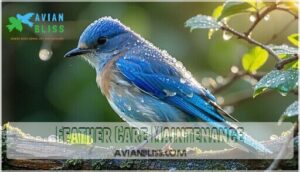This site is supported by our readers. We may earn a commission, at no cost to you, if you purchase through links.
 Bird feathers are complex structures made of keratin that serve multiple critical functions for avian survival.
Bird feathers are complex structures made of keratin that serve multiple critical functions for avian survival.
You’ll find these remarkable adaptations consist of a central shaft with interlocking barbs and barbules that create lightweight yet strong surfaces.
Different feather types include contour feathers for streamlined flight, down feathers for insulation, and specialized flight feathers that generate lift and thrust.
The intricate microscopic hooks allow feathers to zip together like nature’s velcro, maintaining their aerodynamic properties even during vigorous activity.
These structures undergo regular molting cycles, replacing worn feathers with fresh ones.
The engineering behind these natural marvels reveals secrets about thermal regulation, waterproofing, and aerodynamics that continue to inspire modern technology.
Table Of Contents
- Key Takeaways
- Feather Structure Basics
- Types of Bird Feathers
- Feather Growth Development
- Feather Functions Benefits
- Feather Care Maintenance
- Frequently Asked Questions (FAQs)
- What is fright stress or shock moult?
- What are bird feathers made of?
- Why do some birds have crests?
- What are the feathers on a bird called?
- What are the types of feathers in birds?
- What are the feathers of birds called?
- Can I keep a hawk feather I found?
- Why is it illegal to collect bird feathers?
- What are birds feathers called?
- Is it OK to pick up bird feathers?
- Conclusion
Key Takeaways
- **You’ll find that feathers are made of beta-keratin with interlocking barbs and barbules that create lightweight yet incredibly strong structures, functioning like nature’s microscopic velcro system.
- **Your bird’s feathers serve multiple critical functions, including flight control through specialized remiges, thermal regulation via down feathers, and waterproofing through overlapping contour feathers.
- **You can identify different feather types by their structure: pennaceous feathers have rigid vanes for flight, plumaceous feathers are fluffy for insulation, and contour feathers create the bird’s streamlined outer shell.
- **You’ll observe that birds spend up to 25% of their time maintaining their feathers through preening, molting cycles, and dust bathing to ensure optimal performance for survival and flight capabilities.
Feather Structure Basics
When you examine a feather closely, you’ll discover an intricate architectural marvel built from keratin—the same protein that forms your hair and nails.
The central shaft, called the rachis, serves as the backbone from which thousands of barbs extend outward, each connected by tiny barbules that zip together like microscopic velcro to create the smooth, unified surface you see, which is a remarkable example of microscopic velcro.
Keratin Composition
Keratin serves as nature’s engineering marvel in bird feathers.
You’ll find this protein forms microscopic filaments embedded within a keratin matrix, creating structures that balance strength with flexibility.
Beta-keratin provides the primary structural framework, while amino acids like cysteine create essential cross-links through sulfur bonds.
This feather composition enables remarkable durability – feathers resist solar radiation, enzymes, and mechanical stress while remaining lightweight.
The feather anatomy relies on specific amino acid sequences that vary between species, with structural color emerging from keratin’s microscopic arrangements.
- Beta-keratin dominance: Primary protein providing structural integrity and resistance to environmental damage
- Amino acid variation: Species-specific sequences determine feather strength and flexibility characteristics
- Sulfur bond networks: Disulfide bridges maintain feather shape under flight stress and weather exposure
- Keratin matrix structure: Microscopic filaments create composite material stronger than steel by weight
- Structural color formation: Keratin arrangements with air pockets produce iridescent displays without pigments
Central Shaft Anatomy
The rachis forms your feather’s structural backbone, extending from the hollow calamus base.
This rachis strength comes from its lightweight yet durable design, while shaft flexibility prevents breakage during flight maneuvers.
The calamus anchors securely in follicles, creating stable barb attachment points along the rachis.
Together, these components form the foundation for proper feather anatomy and function.
Barb and Barbule Formation
You’ll discover how these intricate structures create flight-worthy surfaces through precise feather development patterns.
Each barb extends from the central shaft at carefully measured angles, while specialized barbules lock together like miniature zippers.
Here’s how Barb Development and Barbule Interlocking work together:
- Barbs grow at 45-degree angles from the rachis during feather structure formation
- Barbules branch from barbs, featuring hook-like barbicels for secure attachment
- Barbicel Function creates interlocking mechanisms that maintain Vane Cohesion
- Feather keratin strengthens barbule connections, ensuring Feather Strength during flight
- Hooklets engage neighboring structures, forming the unified surface you see
This barbule interlocking system transforms individual filaments into cohesive, flexible surfaces.
Vane and Feather Shape
Once barbs emerge from the rachis, they form the vane through barbule interlocking mechanisms that create vane asymmetry in flight feathers. This barbule interlocking system produces the feather aerodynamics necessary for efficient flight performance.
Shape variation across species reflects specialized functions. Feather morphology differences enable species identification through vane characteristics alone.
| Feather Type | Vane Characteristics | Aerodynamic Function | Species Example |
|---|---|---|---|
| Primary Flight | Asymmetrical, rigid vanes | Maximum lift generation | Hawks, eagles |
| Secondary Flight | Symmetrical, flexible vanes | Stability and control | Songbirds, doves |
| Contour Body | Smooth, overlapping vanes | Streamlining airflow | Most flying birds |
| Display | Ornate, specialized shapes | Visual communication | Peacocks, mallards |
Understanding vanes and feather shape helps you recognize how feather structure directly impacts bird behavior and habitat preferences.
Types of Bird Feathers
You’ll encounter five distinct feather types when studying birds, each serving specific biological functions.
These feather categories differ in structure, placement, and purpose, from the rigid flight feathers that power aerial movement to the fluffy down feathers that provide essential insulation.
Pennaceous Feathers
Pennaceous feathers represent the workhorses of bird flight, equipped with sophisticated barb interlocking systems that create their characteristic vane structure.
These feathers feature barbules with tiny hooklets that zip together like microscopic velcro, forming smooth, continuous surfaces perfect for aerodynamics.
This flight adaptation allows birds to manipulate air currents with remarkable precision during takeoff, soaring, and landing maneuvers.
The rigid yet flexible design of pennaceous feathers makes feather identification straightforward for researchers studying different species.
You’ll notice significant species variation in their morphology, with raptors displaying broader, more rigid structures compared to songbirds’ narrower configurations.
This feather structure directly correlates with each bird’s specific flight requirements and hunting strategies.
- Barbules lock together through microscopic hooks creating unified surfaces
- Vane structure provides essential lift and thrust during powered flight
- Flight feathers demonstrate remarkable durability under aerodynamic stress
- Species-specific adaptations reflect unique ecological niches and behaviors
Plumaceous Feathers
You’ll often spot plumaceous feathers providing Plumaceous Insulation beneath contour feathers.
These fluffy down feathers lack interlocking Barbule Structure, creating loose barbs that trap air for exceptional thermal regulation.
Their Softness Adaptations make them perfect for Chick Development and adult warmth.
Some species feature Powder Down that creates waterproofing dust, while plumulaceous feathers offer superior insulation compared to structured flight feathers.
Contour Feathers
Contour feathers create your bird’s polished exterior, like nature’s own aerodynamic shell.
These specialized structures determine body shape while providing weather protection through their overlapping arrangement.
- Contour functions include streamlining airflow around the body
- Contour adaptations feature interlocking barbules for structural integrity
- Contour placement follows precise patterns for ideal feather characteristics
Flight Feathers
Flight feathers, known as remiges, are your bird’s precision-engineered tools for mastery of the skies.
Primary remiges generate thrust through aerodynamic lift, while secondary remiges create lift surfaces.
Barbule interlocking guarantees structural integrity during demanding flight styles.
Strong feather anchorage connects these aerodynamic feathers directly to wing bones.
Molt patterns replace them gradually, maintaining continuous flight capability throughout the year.
These feathers’ structure relies on interlocking barbs for a smooth vane.
Down Feathers
Nature’s most sophisticated insulation system lies beneath your bird’s outer feathers.
Down feathers create remarkably efficient thermal barriers without the rigid structure of flight feathers.
These plumaceous structures feature loose, fluffy barbules that trap warm air like microscopic sleeping bags.
You’ll find three main types serving different purposes throughout a bird’s life:
- Natal down: The first fuzzy coat protecting newly hatched chicks during vulnerable early weeks
- Definitive down: Adult insulation properties that regulate body temperature year-round
- Semiplumes: Hybrid structures combining down’s warmth with some structural support
- Hypoallergenic down: Waterfowl species produce premium nesting material prized for human bedding
Chick thermoregulation depends entirely on this natural insulation since young birds can’t generate sufficient body heat independently.
Down harvesting from domestic waterfowl provides sustainable materials, though wild collection remains illegal under federal law.
Feather Growth Development
You’ll discover how feathers grow from specialized follicles through a remarkable process of cellular development and protein formation.
Nature crafts each feather through an extraordinary cellular symphony, transforming simple protein into flight-ready marvels.
Understanding the molting cycle and growth factors reveals why birds maintain their incredible flying abilities throughout their lives, which involves a complex process related to the growth factors.
Follicle Growth Process
Feather growth starts when follicle cell division activates deep within your bird’s skin.
Rich blood supply delivers nutrients to these tiny factories, creating blood feathers during early development.
Growth hormone regulation controls the timing, while keratinization transforms soft tissue into durable keratin.
Feather size determination occurs as keratin deposition builds the structure.
A protective sheath surrounds feather emergence until maturity.
Molting and Replacement
When birds swap out old feathers, they’re basically giving themselves a complete wardrobe makeover on nature’s timeline.
Your bird’s body carefully orchestrates this feather replacement process, balancing energy demands with flight safety. Most species complete their molt gradually to maintain aerial abilities throughout the change.
During this time, protein-rich foods are especially important.
- Molt Timing: Daylight changes and breeding cycles trigger when feather shedding begins, with shock molt occurring during extreme stress
- Molt Frequency: Complete feather replacement happens 1-2 times yearly, while flight feathers regenerate over several years
- Feather Growth: New feathers push out old ones through follicles, requiring 25% more calories and preen oil for proper feather molting
Factors Affecting Growth
Understanding what shapes your bird’s feather growth starts with knowing that multiple forces work together.
Dietary Influence proves most significant – methionine and cystine deficiencies create weak, malformed feathers. Environmental Impact includes temperature extremes and poor lighting that disrupt Molt Cycle timing.
Genetic Predisposition determines growth rates, while Hormonal Regulation controls when feathers develop. Feather nutrition requires balanced protein levels for proper feather health.
Recent studies show that weather affects avian growth, influencing nestling survival.
| Factor | Effect | Solution |
|---|---|---|
| Poor Diet | Brittle feathers | Balanced nutrition |
| High Stress | Delayed molting | Calm environment |
| Illness | Patchy growth | Veterinary care |
Feather Formation and Structure
From microscopic building blocks, each feather develops through four distinct stages:
- Follicle establishment – The growth foundation forms in skin tissue
- Keratin deposition – Proteins build the rachis and barb framework
- Barbule branching – Microscopic structures create interlocking vane systems
- Pigment integration – Feather pigments and structural coloration determine final appearance
This feather evolution process produces diverse feather types with specialized feather anatomy, enabling complex feather functions from flight to display.
Feather Functions Benefits
You’ll discover that feathers aren’t just beautiful—they’re sophisticated biological tools that solve multiple survival challenges at once.
From maintaining perfect body temperature in arctic winds to enabling precise aerial maneuvers, these remarkable structures demonstrate nature’s engineering at its finest.
Insulation and Thermoregulation
Down feathers create nature’s most efficient insulation system through their unique feather density and structure.
You’ll find these specialized bird feathers trap air close to the body temperature regulation zone, enabling remarkable heat retention during harsh conditions.
This sophisticated down insulation allows climate adaptation by maintaining core temperature while minimizing energy expenditure.
The air trapping mechanism within avian anatomy showcases brilliant natural engineering that supports thermoregulation across diverse environments, from arctic tundra to desert nights.
Flight and Aerodynamics
When feathers meet physics, they create nature’s most sophisticated flight instruments. Your primary remiges generate powerful lift and thrust while maintaining precise airfoil design for maximum efficiency.
Wing feathers work together through strategic feather arrangement, allowing birds to execute complex flight maneuvers and master advanced soaring techniques. These feathers are composed of lightweight keratin, providing durability and flexibility.
- Primary remiges produce forward thrust during powerful wingbeats
- Airfoil design of flight feathers creates lift through curved upper surfaces
- Feather arrangement reduces drag while maintaining wing stability during flight
- Flight maneuvers become possible through individual feather adjustments and positioning
- Soaring techniques utilize feather flexibility to catch thermals and air currents efficiently
Display and Communication
Beyond flight mechanics, Visual Signaling transforms bird feathers into nature’s most sophisticated communication system.
You’ll observe Courtship Plumage where males flash brilliant colors to attract mates, while Territorial Displays use ruffled neck feathers and spread wings to assert dominance.
These Feather Postures enable Species Recognition and convey social status through intricate positioning.
Bird feathers also produce sounds through aeroelastic flutter, contributing to communication.
| Display Type | Feather Features | Communication Purpose |
|---|---|---|
| Mating Rituals | Colorful tail fans, raised crests | Attract mates, show genetic fitness |
| Territorial Claims | Ruffled neck feathers, spread wings | Assert dominance, defend resources |
| Social Hierarchy | Fluffed postures, withdrawn heads | Signal submission or aggression |
| Alarm Calls | Erect body feathers, wing positioning | Warn flock members of danger |
Camouflage and Concealment
Birds deploy sophisticated camouflage through feather colors and patterns that blend seamlessly with their environment.
You’ll witness how seasonal plumage changes provide year-round concealment while cryptic behavior enhances their invisibility.
- Disruptive coloration breaks up body outlines using contrasting patterns for effective predator evasion
- Habitat matching creates perfect visual harmony between bird plumage and surrounding textures
- Seasonal plumage shifts colors from brown winter tones to vibrant breeding displays
Feather Care Maintenance
You’ll discover that feathers aren’t just beautiful structures—they’re sophisticated tools that require constant care to function properly.
Birds spend up to 25% of their waking hours maintaining these essential assets through an intricate system of cleaning, conditioning, and strategic replacement.
Cleaning and Grooming
Daily preening removes dirt and parasites while maintaining feather arrangement.
Preen oil from specialized glands waterproofs and conditions plumage.
Dust bathing absorbs excess oils, while sun bathing eliminates feather lice.
Some species practice anting behavior, rubbing insects on feathers for antimicrobial benefits.
For situations needing more than natural methods, consider using a specialized cleaning product.
| Method | Purpose | Frequency |
|---|---|---|
| Preening | Oil distribution, feather hygiene | Daily, 25% of time |
| Dust bathing | Oil absorption, parasite control | Weekly |
| Sun bathing | Vitamin D, feather maintenance | As available |
| Anting behavior | Antimicrobial feather care | Seasonal |
Protection From Elements
Your bird’s plumage acts like nature’s ultimate protective gear against environmental hazards. Waterproof Mechanisms include interlocking barbs that create seamless barriers, while feather insulation properties trap air for thermal regulation.
Here’s how Feather Density and structure provide thorough protection:
- UV Protection from melanin-rich feathers blocks up to 40% of harmful radiation
- Wind Resistance through overlapping contour feathers prevents heat loss and skin damage
- Seasonal Adaptations adjust plumage thickness for changing weather conditions
- waterproofing via specialized barbule arrangements channels moisture away from skin
To further enhance feather health, consider using specialized feather products. This feather waterproof function and feather insulating function work together, ensuring your bird stays comfortable regardless of weather conditions.
Maintenance and Preening
You’ll notice feather maintenance involves daily preening sessions where birds distribute preen oil from their uropygial gland throughout their plumage.
Dust bathing removes parasites naturally, while feather stretching repositions barbs for ideal function.
Watch for shock molt during stress periods, as molt timing affects overall feather care.
Proper feather maintenance requires consistent grooming behaviors that keep plumage waterproofed and flight-ready through natural feather preen gland secretion.
Keratin and Protein Structure
Your feathers showcase nature’s engineering marvel through beta-keratin structure. This specialized protein creates the foundation for every rachis, barb, and barbule you observe.
Keratin variation among species determines feather flexibility and produces structural color through microscopic arrangements.
Here’s how amino sequences build feather strength:
- Cross-linked proteins form durable yet flexible frameworks
- Microscopic keratin fibers create interlocking barb networks
- Species-specific amino sequences determine unique feather properties
To maintain feather health, consider that essential fatty acids contribute to their shine.
Frequently Asked Questions (FAQs)
What is fright stress or shock moult?
Like a defense mechanism triggered by lightning, shock molt causes you to suddenly drop feathers when experiencing extreme stress or fear.
This dramatic feather loss helps you escape predators by creating a diversion, which can be seen as a dramatic way to ensure survival.
What are bird feathers made of?
You’ll find that bird feathers consist primarily of β-keratin, the same strong protein that forms reptile scales.
This keratin creates microscopic filaments embedded in a matrix, giving feathers their remarkable strength and flexibility for flight.
Why do some birds have crests?
Picture a crown of feathers dancing in the breeze—that’s nature’s royal headpiece in action.
You’ll find birds sport crests for communication, attracting mates, showing dominance, or expressing emotions like excitement or alarm through dramatic feather displays, which can include actions like dancing.
What are the feathers on a bird called?
Birds have several types of feathers you’ll recognize: contour feathers create their sleek outer shape.
Down feathers provide insulation underneath, and flight feathers on wings and tails enable soaring through skies.
What are the types of feathers in birds?
Back in Victorian times, naturalists classified feathers into distinct types.
You’ll find flight feathers for lift and propulsion, down feathers for insulation, contour feathers for streamlining, bristles for protection, filoplumes for sensing, and powder down for waterproofing.
What are the feathers of birds called?
Bird feathers have specific scientific names based on their location and function.
You’ll encounter contour feathers covering the body, flight feathers powering movement, down feathers providing insulation, and specialized types like filoplumes for sensing.
Can I keep a hawk feather I found?
As the saying goes, "The best-laid plans of mice and men often go awry" – and keeping that hawk feather you found will certainly go awry with federal law.
You can’t legally keep it since the Migratory Bird Treaty Act protects all raptor feathers from collection.
Why is it illegal to collect bird feathers?
Federal law protects migratory birds through the Migratory Bird Treaty Act, making it illegal to collect feathers without permits.
You’re helping preserve bird populations by leaving feathers where you find them naturally, which is a crucial step in supporting the Migratory Bird Treaty Act.
What are birds feathers called?
You’d think simple body parts would have simple names, but feathers carry specific terminology.
Scientists call them by their location and function: flight feathers include primaries and secondaries on wings, plus tail feathers for steering.
While body feathers encompass contour and down types.
Is it OK to pick up bird feathers?
No, you shouldn’t pick up bird feathers you find.
Federal law prohibits collecting feathers from most North American birds, protecting species from harm.
Instead, photograph and appreciate feathers where you discover them naturally.
Conclusion
Consider a hummingbird’s iridescent throat feathers catching sunlight during rapid flight maneuvers.
Understanding bird feathers reveals nature’s sophisticated engineering solutions for survival challenges. You’ve discovered how these keratin structures balance weight, strength, and functionality through precise molecular arrangements.
From down feathers providing thermal regulation to flight feathers enabling aerodynamic efficiency, each type serves specific purposes. Regular maintenance through preening and molting guarantees peak performance.
Bird feathers continue inspiring biomimetic innovations in materials science and aerospace engineering, demonstrating evolution’s remarkable problem-solving capabilities.














